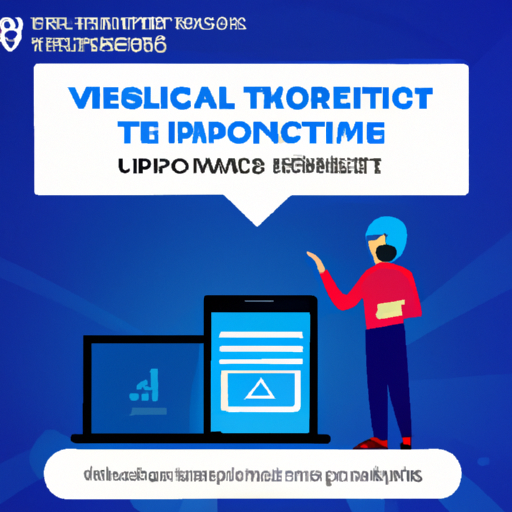Are you looking for opportunities to offer virtual tech support to individuals or businesses? With the rise of remote work and the increasing reliance on technology, there is a growing demand for reliable, accessible, and efficient tech support services. This article explores the potential opportunities in this field, highlighting the benefits of virtual tech support and the potential target market for such services. Get ready to discover a world of possibilities where your tech expertise can make a difference!
Click Here For Top Recommend Online Opportunities
Overview of Virtual Tech Support
Definition of virtual tech support
Virtual tech support refers to the provision of technical assistance and troubleshooting services remotely, without the need for an on-site visit. It involves using technology to identify and resolve issues faced by individuals or businesses, whether they are related to hardware, software, networks, or cybersecurity. Virtual tech support professionals remotely access and control devices to diagnose problems, provide solutions, and offer guidance to clients.
Types of virtual tech support services
There are various types of virtual tech support services available to cater to different needs. Help desk support is a common service that involves addressing customer queries and providing solutions to technical issues. Hardware and software troubleshooting entails diagnosing and resolving problems related to computer systems, peripherals, and software applications. Network setup and maintenance involve assisting clients with configuring, securing, and managing their network infrastructure. Cybersecurity assistance focuses on protecting clients’ data and systems from online threats by implementing security measures and providing guidance on safe practices.
Benefits of Providing Virtual Tech Support
Cost-effectiveness
One of the key advantages of offering virtual tech support is that it is cost-effective for both the service provider and the client. By eliminating the need for on-site visits, companies can save on travel expenses and reduce overhead costs. Clients also benefit from cost savings as they do not have to pay technicians for travel time or expenses. Moreover, virtual tech support allows service providers to assist multiple clients simultaneously, maximizing productivity and efficiency.
Flexibility and convenience
Virtual tech support offers immense flexibility to both service providers and clients. With remote access tools and communication platforms, technicians can provide support from anywhere at any time. This flexibility enables companies to offer 24/7 support and cater to clients’ needs across different time zones. For clients, virtual tech support eliminates the hassle of scheduling appointments and waiting for technicians to arrive on-site. They can simply connect with the support team remotely, making it convenient and time-saving.
Global reach
Another notable benefit of virtual tech support is its global reach. With the internet connecting people worldwide, service providers can offer their expertise to clients in different countries. This opens up opportunities for expanding the client base and reaching markets that may have previously been inaccessible. Additionally, virtual tech support allows businesses to tap into the expertise of specialists from around the world, ensuring they receive the best possible assistance for their technical needs.
Market Demand for Virtual Tech Support
Increasing reliance on technology
As technology continues to advance and become an integral part of our daily lives, the reliance on technology increases. Individuals and businesses heavily rely on various devices, software applications, and networks to perform their tasks efficiently. This growing dependence creates a significant demand for virtual tech support services to address technical issues, provide guidance, and ensure smooth operations.
Growth in remote work
The rise of remote work has further contributed to the demand for virtual tech support. With more employees working from home or remote locations, the need for remote technical assistance has grown. Remote workers depend on reliable technology and connectivity to perform their jobs effectively. Virtual tech support plays a crucial role in troubleshooting issues, ensuring remote workers have a smooth and uninterrupted work experience.
Expansion of online businesses
The expansion of online businesses has also fueled the market demand for virtual tech support. Businesses operating online rely heavily on their website’s performance, software applications, and servers. When technical issues arise, these businesses require immediate assistance to minimize downtime and ensure a seamless customer experience. Virtual tech support services provide the necessary expertise to resolve these issues efficiently, helping online businesses maintain their operations and customer satisfaction.
Challenges and Competitors in the Virtual Tech Support Industry
Competition from established tech support firms
In the virtual tech support industry, there is fierce competition from established tech support firms. These companies have a track record of providing reliable and efficient support services, making it challenging for new players to enter the market. To stand out, virtual tech support businesses need to differentiate themselves by offering specialized services, focusing on niche markets, or providing exceptional customer service.
The need for maintaining technical expertise
As technology continues to evolve, virtual tech support professionals must constantly update their technical knowledge and skills. Staying up-to-date with the latest advancements and trends is crucial to ensure the ability to effectively troubleshoot and support a wide range of devices and software. This ongoing learning process can be time-consuming and challenging, requiring virtual tech support professionals to invest in continuous education and training programs.
Building trust with virtual clients
Building trust with virtual clients can be a hurdle in the virtual tech support industry. Without face-to-face interactions, it is important to establish credibility and reliability through effective communication, prompt responses, and successful issue resolution. Virtual tech support businesses need to prioritize proactive communication, transparency, and consistency to build trust with clients and foster long-term relationships.
Types of Virtual Tech Support Jobs
Help desk support
Help desk support professionals provide technical assistance to end-users, resolving their IT-related issues through phone, email, or chat. They are responsible for troubleshooting problems, providing guidance, and escalating complex issues when necessary. Help desk support professionals possess strong technical knowledge, communication skills, and patience to assist clients effectively.
Hardware and software troubleshooting
Professionals specializing in hardware and software troubleshooting are experts in resolving issues related to computer systems, peripherals, and software applications. They diagnose problems, conduct tests, and provide solutions to ensure the smooth functioning of hardware and software systems. Strong problem-solving abilities, technical expertise, and attention to detail are vital for success in this role.
Network setup and maintenance
Network setup and maintenance professionals assist clients with configuring, securing, and managing their network infrastructure. They ensure that the network setup meets the client’s requirements, troubleshoot network issues, and implement security measures to protect against cyber threats. In-depth knowledge of networking protocols, security protocols, and network hardware is essential for this role.
Cybersecurity assistance
Cybersecurity assistance professionals focus on protecting clients’ data and systems from online threats. They help implement security measures, conduct vulnerability assessments, and provide guidance on best cybersecurity practices. In-depth knowledge of cybersecurity frameworks, threat detection tools, and incident response procedures is crucial for effectively addressing cybersecurity challenges.
Skills and Qualifications for Virtual Tech Support
Strong technical knowledge
Virtual tech support professionals must have a strong foundation in technical knowledge and expertise. They should possess a deep understanding of computer systems, software applications, networks, and cybersecurity. Regularly updating their knowledge and staying informed about the latest technological advancements is imperative to provide effective support and solutions.
Communication and problem-solving skills
Excellent communication skills are critical for virtual tech support professionals. They need to communicate technical information in a clear and concise manner to clients who may have varying levels of technical knowledge. Additionally, problem-solving skills are essential in identifying and resolving technical issues efficiently. Virtual tech support professionals should be adept at analyzing problems, troubleshooting, and finding solutions within a reasonable timeframe.
Certifications and training
Obtaining relevant certifications and participating in training programs can significantly enhance the skills and qualifications of virtual tech support professionals. Certifications such as CompTIA A+, Microsoft Certified Solutions Expert (MCSE), Cisco Certified Network Associate (CCNA), and Certified Ethical Hacker (CEH) can validate their expertise and demonstrate their commitment to professional development. Continuing education and staying updated with industry best practices further contribute to their qualifications.
Tools and Technologies Used in Virtual Tech Support
Remote access software
Remote access software allows virtual tech support professionals to remotely access and control devices to diagnose and resolve technical issues. Examples of commonly used remote access software include TeamViewer, AnyDesk, and LogMeIn. These tools enable technicians to view a client’s screen, transfer files, and provide real-time support without the need for physical presence.
Live chat and messaging platforms
Live chat and messaging platforms facilitate real-time communication between virtual tech support professionals and clients. These platforms, such as LiveChat, Zendesk Chat, and Slack, enable quick and efficient communication, allowing clients to describe their issues and receive immediate assistance. Live chat and messaging platforms also enable the storage of conversation histories, ensuring a seamless flow of information.
Ticketing systems
Ticketing systems help virtual tech support businesses streamline their support processes and track customer requests. These systems, such as Zendesk, Freshdesk, and Jira Service Management, allow clients to submit support tickets, which are then assigned to the appropriate technician. Ticketing systems ensure that inquiries are properly documented, prioritize requests, and provide visibility into the status of ongoing support tickets.
Diagnostic tools
Diagnostic tools are used by virtual tech support professionals to identify and troubleshoot technical issues efficiently. These tools help diagnose hardware, software, and network problems by running tests, scanning for errors, and generating reports. Popular diagnostic tools include CPU-Z, Memtest86, Wireshark, and PingPlotter.
Steps to Start a Virtual Tech Support Business
Market research and business planning
Before starting a virtual tech support business, conducting market research is essential to identify target markets and assess the demand for services. Understanding competitors, pricing models, and industry trends helps in developing a comprehensive business plan. The business plan should outline the services offered, target clients, marketing strategies, and financial projections.
Defining service offerings and pricing
Clearly defining the services to be offered is crucial in positioning the virtual tech support business in the market. Determine the scope of services, such as help desk support, hardware troubleshooting, network setup, or cybersecurity assistance. Pricing should be competitive while considering factors such as service complexity, time involved, and certifications held by technicians.
Setting up a virtual office
Setting up a virtual office is an important step in establishing a virtual tech support business. Virtual offices allow technicians to work remotely while ensuring a professional and efficient support operation. Consider investing in a reliable internet connection, remote access tools, communication platforms, and collaboration software. Additionally, establish processes for ticket management, document sharing, and client relationship management.
Marketing and client acquisition strategies
To attract clients, effective marketing and client acquisition strategies are crucial. Develop a strong online presence by creating a professional website, optimizing it for search engines, and leveraging social media platforms to promote services. Networking, partnerships, and referrals can also play a vital role in acquiring clients. Providing exceptional customer service and building relationships is key to retaining clients and generating positive word-of-mouth.

Factors to Consider when Providing Virtual Tech Support
Time zone differences and availability
When providing virtual tech support, considering time zone differences and availability is essential. Clients may seek support at any time, and virtual tech support businesses need to set clear expectations regarding support hours. Offering 24/7 support or having technicians available during overlapping time zones can enhance customer satisfaction and widen the client base.
Security and data privacy
Virtual tech support businesses must prioritize security and data privacy to establish trust with clients. Adhering to industry best practices, using secure communication channels, and implementing data encryption measures are essential. Technicians should also be trained on handling sensitive client information and following data protection regulations to ensure confidentiality and mitigate the risk of security breaches.
Effective communication with clients
Clear and effective communication is vital in providing virtual tech support. Technicians should have excellent verbal and written communication skills to understand clients’ issues, relay technical information, and guide them through troubleshooting steps. Active listening, patience, and empathy are also important in building rapport and ensuring clients feel supported and understood.
Managing client expectations
Managing client expectations is crucial to prevent misunderstanding and ensure a positive experience. Clearly communicate the scope of services provided, expected response times, and potential limitations. Transparency about pricing, service level agreements, and technical feasibility can help set realistic expectations upfront. Regular communication and updates regarding progress and issue resolution are important to keep clients informed.
Future Trends in Virtual Tech Support
Artificial intelligence and chatbot integration
Artificial intelligence (AI) and chatbot integration are becoming increasingly common in virtual tech support. AI-powered chatbots can handle basic support queries, provide automated responses, and escalate complex issues to human technicians. This integration improves response times, reduces support costs, and enhances customer experience by providing instant assistance.
Enhanced remote diagnostics
Advancements in technology are enhancing remote diagnostics capabilities for virtual tech support professionals. Remote diagnostic tools can perform deep scans, collect diagnostic data, and identify potential issues without physical access to devices. This enables technicians to troubleshoot and resolve problems expediently, reducing the need for on-site visits and minimizing downtime for clients.
Wireless and IoT support
With the increasing prevalence of wireless technologies and Internet of Things (IoT) devices, virtual tech support professionals need to be equipped to handle related challenges. Providing support for wireless networks, IoT devices, and smart home systems will continue to be in demand. Proficiency in troubleshooting Wi-Fi connections, configuring IoT devices, and securing wireless networks will be valuable skills.
Virtual reality-based support services
Virtual reality (VR) has the potential to revolutionize the virtual tech support industry by enabling immersive and hands-on support experiences. By using VR headsets and virtual environments, technicians can guide clients through complex troubleshooting procedures, provide interactive training, and simulate on-site visits. VR-based support services can enhance efficiency, reduce travel costs, and provide a more engaging support experience for both technicians and clients.
In conclusion, the demand for virtual tech support is on the rise due to the increasing reliance on technology, growth in remote work, and expansion of online businesses. Though there are challenges and competitors in the industry, virtual tech support businesses can thrive by offering specialized services, maintaining technical expertise, and building trust with clients. Various types of virtual tech support jobs require strong technical knowledge, communication skills, and certifications. The industry relies on tools and technologies such as remote access software, live chat platforms, ticketing systems, and diagnostic tools. Starting a virtual tech support business involves market research, defining services and pricing, setting up a virtual office, and implementing effective marketing strategies. Factors such as time zone differences, security, communication, and client expectations should be considered to provide exceptional virtual tech support. Looking to the future, virtual tech support will continue to evolve with the integration of AI, enhanced remote diagnostics, wireless and IoT support, and the emergence of VR-based support services.







